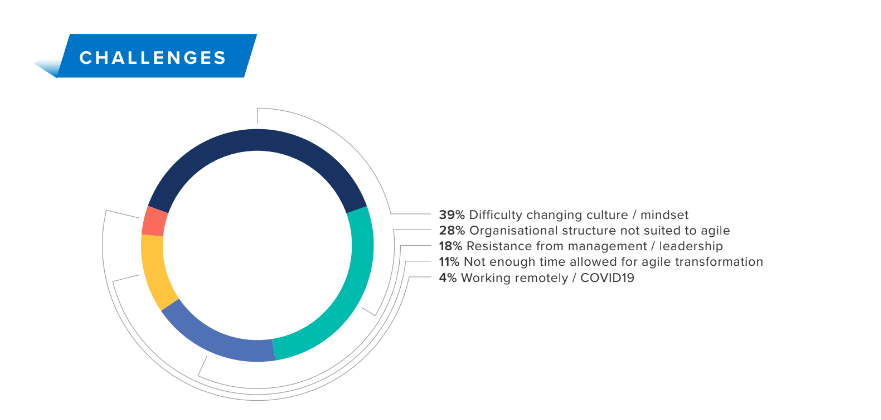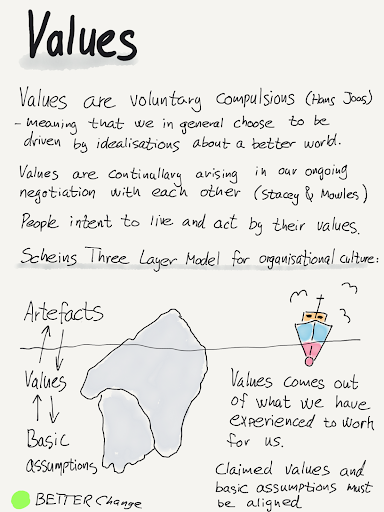Learn about purchasing for teams
5 Effective Strategies to Encourage Agile Mindset Shift in Organizations

In the 2022 State of Agile Coaching report, changing an organization’s culture and mindset was reported as the top challenge:

Knowing this is a common hurdle, how can coaches help teams, businesses, and leaders transform? How can we overcome the existing mindsets and resistance to change that are barriers to an agile way of working? Below, we look at several techniques that help and a few that don’t.
To Help People Make Sense of the Unknown and the New, Start with Leadership
When changing organizational behavior, it’s important to understand that human beings act according to individual values and intentions. Agile coaches might define strategies for mindset change, but what happens in organizations happens because human beings do what makes sense to them. Therefore it is fundamental to focus on sensemaking when changing culture - help people make sense of what is happening even though it is new and different.
Supporting leaders, businesses, and teams as they make sense of change often boils down to the fifth principle in the Agile Manifesto: “Build projects around motivated individuals, give them the environment and support they need, and trust them to get the job done”. We start with the leadership of a business or team.
As Edgar Schein stated: “Leadership and culture are the head and tail of the same coin”. Employees do not act according to what they are told; they act according to what they experience. Leaders need to shape that experience and sensemaking by taking their own medicine. They must act with integrity (which means that even their knee-jerk reactions must be in line with the values they claim to have), and they must behave in a way that helps their employees act, succeed, and grow. To summarize: Heavily investing in leadership skills and self-awareness is an effective strategy to encourage agile culture change.
Strategies for Agile Coaches to Encourage Mindset Shift
Get Leaders Outside of the Training Room
It’s important to take leaders beyond the training room. Learning about leadership archetypes like the Expert, Achiever, and Catalyst, as well as culture models like the Competing Values Framework is great, but helping the leader to understand and reflect on their behavior in a safe and confidential environment, like a leadership cohort, is an essential hands-on step beyond those academic aspects of leadership.
“To become a leader is to become yourself - it is that simple and that difficult at the same time”, as Warren Bennis stated it. In the cohorts I facilitate we start by focusing on what the individual leader is already doing well and then build on top of that by sharpening the awareness of several areas, including:
- The importance of being present
- Small talk as a way of reducing anxiety
- Recognizing own biases and habits
- Building up the ability to navigate in unpredictable conditions rather than trying to learn how to manage uncertainty
Structural Support for Agile Change
Leadership must provide structures to drive the desired behavior in the organization or team(s). For example, there is a lot to learn from the practice of nudging. You can nudge people toward collaboration by reevaluating team formation, office layout, and available tools. Structural support may also be defining new agile-friendly processes and, more importantly, removing the unfriendly ones. Applying structures may involve setting up metrics so that teams and leaders are focusing on the outcome we want rather than various outputs of no real value.
The Three Cs of Change Management
The 3 Cs of change management are communicate, communicate, and communicate. You can almost only communicate too little. We are trying to change the behavior of people who are acting according to their intent. This is beyond our control, so the best we can do is to share our intent (the big why), our ambitions, and to what degree we succeed. Both successes and failures must be communicated. Try to avoid the situation in which people are wondering whether they have heard the whole truth or not.
Focus on Quick Wins to Motivate People
A great motivator is the good feelings that come after achieving a result. Endorphins are released when we accomplish something, making us feel happier. Additionally, success becomes part of the narrative of the business when wins are achieved.
To catalyze wins, pick a team that already has the conditions and scenario set for success. At the same time, you don’t want to make it seem artificially convenient to get a win. By identifying the conditions that lead to results, you can adapt the process to other teams later on.
As teams and individuals achieve desired results, the feeling of success amplifies and builds on itself. Of course, success isn’t always guaranteed and it’s important to be transparent about failures as well. Remember to celebrate both.
New Mindsets Require Practice and Repetition
Adopting new behaviors and habits is much more difficult than simply forgetting old habits. As organizations, leaders, and teams work to shift their mindsets and change their cultures, they should be transparent about the process and hold one another accountable. Oftentimes the new behavior must be practiced almost mechanically for a long time before it becomes the dominant culture and way of working. Forming a new culture is a long process that requires constant and determined focus and investment.
Techniques That Don’t Work
Here are a few techniques that, in my experience, do not work:
- Trying to create change with a slide presentation. It is not enough to do a presentation or two and expect meaningful change. Instead, cultural shifts and agile evolutions require leaders and teams to practice new values every day.
- Neglecting to live by the values created. According to Schein’s three-layer model for organizational culture (normally visualized by an iceberg), stated values and what we really believe in must be aligned, otherwise the stated values are merely decorative. This is especially important for those in leadership positions. Employees tend to take the mindset shift less seriously or even leave the job entirely if they do not see leadership leading by example.

- Using dogmatic and judgmental agile coaches. As an agile coach, I focus on helping organizations improve their way of working, starting with the values and principles of the Agile Manifesto. At the same time, I want to meet people where they are, right now, in the real world.
For some people, the gap between where they are and the ideas within the Agile Manifesto is expansive. Agile coaches must recognize where individuals, teams, and organizations are in their journeys and coach them accordingly.
Coaches must realize that adopting new values isn’t easy. When coaches encounter what at first appears to be dysfunctional behavior related to culture and mindset shift, what they are often seeing is people acting according to their own values. When coaching, you are trying to inject an appropriate disturbance into their normal way of thinking. A drastic disturbance is unlikely to succeed because people naturally want to align themselves with their values. If a person whose way of thinking differs greatly from the Agile Manifesto is confronted with a dogmatic and judgemental agile coach, then that person will simply shut down and not listen. They may become a contrarian to what you are trying to accomplish, and therefore a significant source of resistance to your initiative.
Sign up below to download the 2022 State of Agile Coaching Report.










